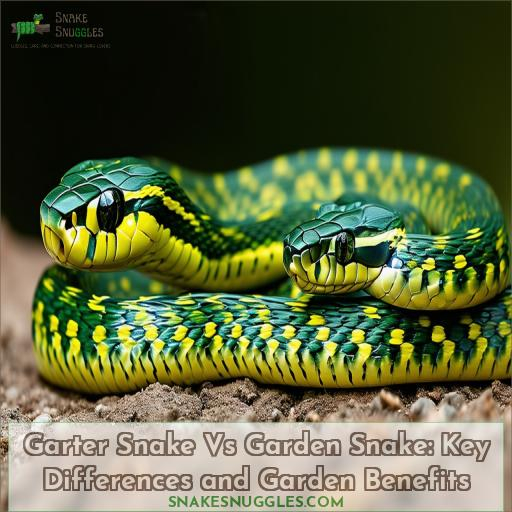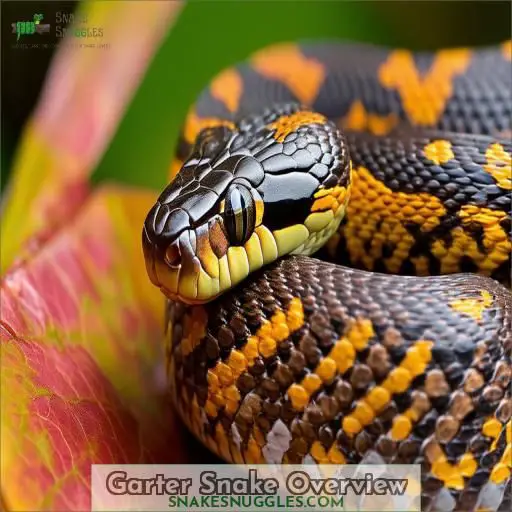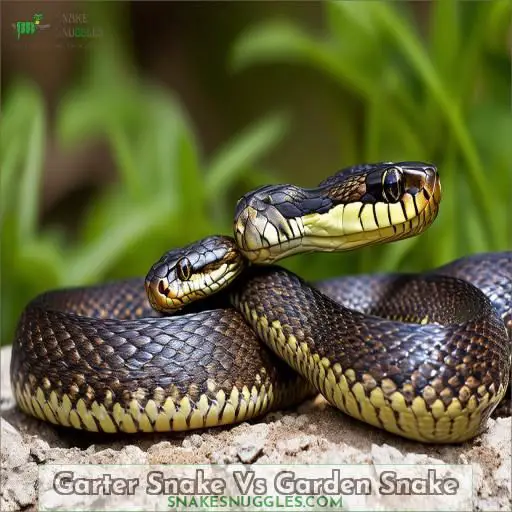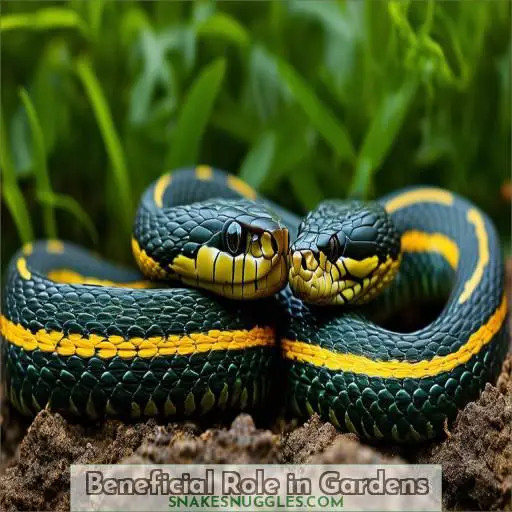This site is supported by our readers. We may earn a commission, at no cost to you, if you purchase through links.
 While both garter snakes and garden snakes are harmless reptiles, you’ll notice distinct differences in their appearance and behavior.
While both garter snakes and garden snakes are harmless reptiles, you’ll notice distinct differences in their appearance and behavior.
Garter snakes sport bolder, checkered stripe patterns along their bodies, while garden snakes lack these distinctive markings.
Additionally, garter snakes thrive in diverse habitats like meadows and marshes, whereas garden snakes prefer wooded areas.
Despite these key differences between garter snake and garden snake, both species play beneficial roles in gardens by preying on pests like insects and rodents.
Intrigued by how these slithering allies contribute to a balanced ecosystem?
Table Of Contents
- Key Takeaways
- Garter Snake Overview
- Physical Characteristics
- Habitat and Behavior
- Garter Snake Vs Garden Snake
- Beneficial Role in Gardens
- Conservation Status
- Frequently Asked Questions (FAQs)
- Is a garter snake the same as a garden snake?
- How do you tell if a snake is a garden snake?
- What is the difference between a grass snake and a garter snake?
- Are garter snakes good to have in your yard?
- Are garter snakes and gardener snakes the same?
- Do garter snakes pose any danger to pets?
- Can garter snakes climb trees or walls?
- How do I keep garter snakes away from my home?
- At what age do garter snakes become reproductive?
- Conclusion
Key Takeaways
- Listen, you might think all snakes are the same slimy creatures, but there are actually some pretty nifty differences between garter snakes and garden snakes. For starters, garter snakes rock those bold, checkered stripe patterns like a fashion statement, while garden snakes keep things a little more low-key.
- When it comes to living the high life, garter snakes are the true jet-setters. They thrive in diverse habitats like meadows and marshes, while garden snakes prefer to stick to their woodsy roots. It’s like having a travel bug versus being a homebody!
- Sure, they might look a little different and have varying vacation preferences, but both garter snakes and garden snakes are total MVPs when it comes to keeping your garden in tip-top shape. These slithery pals love nothing more than chowing down on pesky insects and rodents, so they’re like nature’s own personal pest control squad.
- At the end of the day, whether it’s a garter snake or a garden snake, you’ve got to appreciate these harmless reptiles for the true marvels of nature that they are. They’ve been around for millions of years, playing their part in maintaining the delicate balance of ecosystems. So, the next time you see one of these scaly friends, give them a little nod of respect – they’re doing some serious heavy lifting in the gardening department!
Garter Snake Overview
You’re about to explore the fascinating world of garter snakes!
These harmless reptiles have evolved over millions of years, becoming an integral part of our ecosystems. While they may seem intimidating, garter snakes are typically docile and non-aggressive unless provoked. In fact, their mild venom poses little threat to humans.
With an average lifespan of 3-10 years in the wild, garter snakes play a key role in controlling pest populations.
Common throughout North America, these snakes sport distinctive stripes along their bodies – a trait shared by their close cousins, the eastern ribbon snakes.
Get ready to discover the unique behaviors and incredible adaptations that make garter snakes true marvels of nature!
Physical Characteristics
Garter snakes exhibit a wide range of body markings, from bold stripes running laterally along their slender bodies to intricate checkered patterns. Their size and shape can vary, with some species reaching around 4 feet in length, while others remain relatively small, typically under 2 feet; their cylindrical bodies are distinctly thicker in males compared to slender females.
Body Markings
Garter snakes display striking patterns that aid in:
- Camouflage from predators
- Warning potential threats
- Identifying mates
Their iconic yellow-striped bodies may feature checkered patterns, glossy scales, or long tails. This pattern variability reflects geographic distribution and potential mimicry of other snakes they co-exist with in overlapping habitats.
Size and Shape
You’ll notice garter snakes have a robust body shape, with lengths ranging from 18-51 inches (46-130 cm). The thickness varies, with males generally stouter than females.
| Subspecies | Length Range |
|---|---|
| Common Garter Snake | 18-26 inches |
| Ribbon Snake | 16-28 inches |
| Texas Garter Snake | 24-42 inches |
Compared to the slender ribbon snake, garter snakes have a more cylindrical girth, well-suited for their environments.
Color Variations
You’ll notice garter snakes display a variety of colors and stripe patterns depending on their species and habitat. The common garter boasts three distinct yellow stripes running down its greenish-brown body. In contrast, the endangered San Francisco garter snake sports striking black and vivid red stripes, with an unmistakable orangey-red head.
Habitat and Behavior
Garter snakes inhabit a wide range of habitats, including meadows, marshes, woodlands, and even suburban areas.
They seek out damp environments and prey on insects, amphibians, and small rodents.
These semi-aquatic snakes are adept swimmers.
They often bask near water sources.
Breeding occurs in spring when males engage in courtship rituals around females, leading to live births later in the season.
Preferred Environments
You’ll find garter snakes slithering through marshy areas, near waterbodies, and along woodland edges. These harmless serpents thrive in damp meadows and aquatic habitats. As a common sight in Massachusetts, they play an important role in the food chain, giving live births after forming unique mating balls during breeding season.
Feeding Habits
You’ll find garter snakes feasting on a variety of prey including:
- Insects like crickets and grasshoppers
- Amphibians such as frogs and salamanders
- Small fish inhabiting ponds or streams
- Rodents like voles, shrews, and young mice
Their diverse diet makes them efficient hunters, helping control pest populations in gardens and fields.
Breeding and Reproduction
You’ll witness fascinating mating displays as males vigorously court females through March and April. Successful reproduction results in live births after a 2-3 month gestation period, with up to 50 newborns emerging in late summer. While most garter snakes lay eggs, these live-bearers benefit from carrying developing offspring internally—contributing to their Massachusetts state reptile status and longer tails.
Garter Snake Vs Garden Snake
While garter snakes and garden snakes share some similarities, there are notable key differences between these two reptiles that are important to understand. Both species play beneficial roles in gardens by preying on common pests, but distinguishing their unique physical characteristics and behaviors can help guarantee proper identification and appreciation for their distinct ecological niches.
Key Differences
While garter snakes and garden snakes share some resemblance, you’ll notice distinct differences that aid in identification:
- Garter snakes have bolder, checkered stripe patterns along their bodies
- Garden snakes lack the distinctive white or yellow stripes of garters
- Garter snakes thrive in diverse habitats, while garden snakes prefer wooded areas
Similarities
While garter snakes and ribbon snakes differ in appearance, they share several similarities. Both species have a similar diet, feeding on insects, amphibians, and small mammals. They also face common predators like birds of prey and larger snakes. Additionally, their reproduction involves giving live birth, rather than laying eggs. Conserving these harmless snakes is important as they play a significant role in ecosystem balance.
| Classification | Garter Snake | Ribbon Snake |
|---|---|---|
| Genus | Thamnophis | Thamnophis |
| Species | Numerous | sauritus |
| Diet | Insects, amphibians, small mammals | Insects, amphibians, small fish |
| Predators | Birds, larger snakes, mammals | Birds, larger snakes, mammals |
| Reproduction | Live birth | Live birth |
Beneficial Role in Gardens
You’ll definitely want garter snakes in your garden, as they provide excellent natural pest control by preying on insects, slugs, and other garden pests. Additionally, garter snakes play a crucial ecological role by serving as food sources for predators like hawks and foxes, helping maintain the balance within the ecosystem.
Pest Control
You’ll be delighted to have garter snakes in your garden – these non-venomous slitherers provide excellent pest control by happily gobbling up slugs, insects, and even rodents. Their presence is a garden benefit, keeping pesky critters at bay naturally. So welcome these harmless helpers and let them do their job!
Ecological Importance
You play a pivotal role in maintaining ecological balance by welcoming garter snakes into your garden. Here are some key benefits:
- They help control pest populations, ensuring biodiversity conservation
- As prey, they support food chain dynamics and ecosystem services
- Their presence signifies a healthy, thriving habitat with fewer chemicals
- You actively contribute to preserving nature’s delicate balance
Embrace garter snakes as allies in creating a sustainable, eco-friendly garden paradise.
Conservation Status
You should be aware that garter snakes face various threats, including habitat loss, roadkill, and persecution by humans who wrongly perceive them as dangerous. Fortunately, conservation efforts aim to protect these harmless and beneficial snakes by preserving their natural habitats and educating the public about their important role in controlling garden pests.
Threats
You’ll find garter snakes facing growing threats like hunting grounds destroyed by urban expansion, alarming roadkill rates from vehicles, and habitat loss driven by climate change impacts. In cities, these beneficial garden companions struggle as green spaces shrink and human-wildlife conflicts rise. Protecting their survival means safeguarding essential ecological roles.
Protection Efforts
You can help protect these beneficial garden snakes by supporting habitat conservation efforts. Many organizations work on preserving wetlands and natural areas where garter snakes thrive. Consider volunteering for habitat restoration projects or donating to research initiatives studying their population status. Public education also plays a vital role in reducing persecution and promoting coexistence.
Frequently Asked Questions (FAQs)
Is a garter snake the same as a garden snake?
You’re correct – garter snakes and garden snakes are the same harmless creature. These non-venomous serpents frequent gardens and yards, helping control pests. Recognizing their stripes and slender bodies allows you to identify these beneficial backyard guests.
How do you tell if a snake is a garden snake?
To identify a garden snake, look for bold stripes running along its body, a pale yellow or white underside, and a length of 18-26 inches. These harmless, non-venomous snakes often inhabit gardens, meadows, and damp woods, controlling pests.
What is the difference between a grass snake and a garter snake?
You’d be forgiven for mixing them up—grass snakes and garter snakes share the telltale stripes. But look closely: grass snakes’ stripes run unbroken along slender bodies, while garter snakes sport checkered patterns on stockier frames.
Are garter snakes good to have in your yard?
Yes, garter snakes are excellent garden companions. They help control pests like slugs and mice, reducing your need for chemical pesticides. Their non-venomous nature makes them harmless to humans and pets.
Are garter snakes and gardener snakes the same?
Garter snakes and gardener snakes refer to the same species. These harmless snakes, with their distinct striped patterns, play a beneficial role in controlling pests, making them welcome visitors to gardens and yards.
Do garter snakes pose any danger to pets?
While garter snakes aren’t generally aggressive toward pets, their bites can cause localized swelling and irritation. However, their small size and non-venomous nature make them relatively harmless if left alone. To prevent potential issues, consider relocating garters found near pet areas.
Can garter snakes climb trees or walls?
Garter snakes are poor climbers and typically stick to the ground. While they can climb rough surfaces like brick walls, they generally avoid scaling trees or steep inclines. Their slender bodies excel at traversing grassy areas, brush, and fallen logs near their preferred wetland habitats.
How do I keep garter snakes away from my home?
Picture a harmless garter snake sunbathing near your doorway. To deter them, remove potential hiding spots, seal cracks, and use repellents like ammonia or vinegar around entries. Their presence indicates a balanced ecosystem, but act quickly if concerned for safety.
At what age do garter snakes become reproductive?
Garter snakes typically reach sexual maturity around 2-3 years old. At this age, they’ll start breeding and females can give birth to live young annually. Monitor their growth and provide appropriate housing as they mature.
Conclusion
A snake in the grass may sound alarming, but understanding the difference between garter snake and garden snake reveals their beneficial roles.
You’ve learned how their distinct physical traits, habitats, and behaviors set them apart.
By welcoming these harmless serpents into your garden ecosystem, you leverage nature’s pest control agents and promote ecological balance.
Embrace coexistence with these slithering allies for a thriving, sustainable outdoor space.









